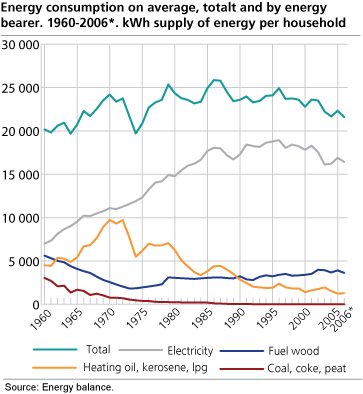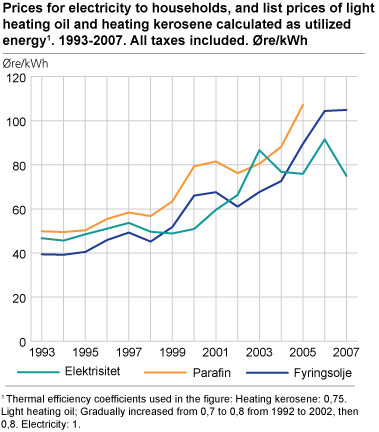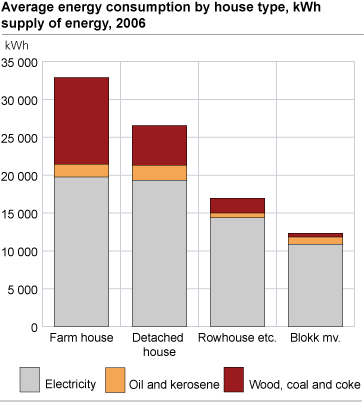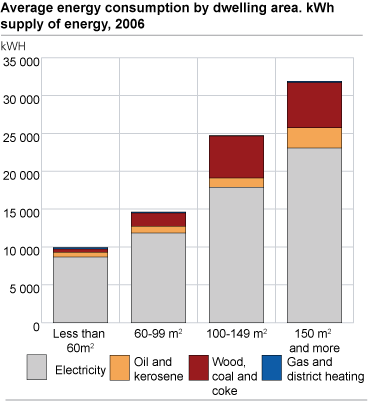Content
Published:
This is an archived release.
Still low energy consumption in households
During the last years, the energy consumption in households has declined, at the same time as there has been an increase in dwelling area. This can be explained by higher energy prices, more focus on energy saving, better insulation and more energy efficient electrical equipment etc.
|
The survey is based on data from the annual Survey of Household Expenditure with additional questions about energy. The purpose of the statistics is to survey the consumption pattern for different household and house types, combinations of heating equipment and to analyse which factors that influence the energy consumption. The results can deviate from results from the annual energy balance and electricity statistics, due to use of other data sources and methods. The survey is based on a sample of 1 010 households and this implies some sample uncertainty. However, calculated confidence interval shows that the energy consumption per household was within 20 900 and 22 400 kWh with 95 per cent probability. |
The energy consumption for stationary purposes per household in 2006 was about 21 600 kWh.
Electricity is the most important energy source in Norwegian households, and accounts for about three quarters of the total stationary energy consumption, or about 16 200 kWh in 2006. In the period 1991 - 2001, the electricity consumption in dwellings (without cottages) was about 18 000 kWh on average, but after a considerable price rise on electricity during the winter 2002/2003, the consumption has declined. Fuel wood is the second most important energy source, and made up about 18 per cent of the total energy consumption in 2006, with about 3 850 kWh. Consumption of oil and kerosene accounted for about 6.5 per cent of the total consumption. Gas and district heating is still of minor importance in Norwegian households, and made up less than 1 per cent of the total consumption in 2006.
Larger dwelling area, but fewer persons
The dwelling area has gradually increased over time, from 101 m2 on average in 1981 to 119 m2 in 2006, even if the household size has decreased. The average household size fell from 2.7 in 1980 to 2.3 in 2006. Higher dwelling area implies more energy needs for heating purposes, while reduced household size lower the energy needs for washing etc. per household. Another factor that influence energy needs is climatic changes, because a large part of the energy consumption in households is used for heating purposes. Since the end of the 1980s, the temperature has been above the climatic normal for the years 1961-1990, except from 1996.
Detached houses use most energy
Households in farm houses and detached houses use most energy, with respectively 32 900 and 26 700 kWh on average in 2006. For comparison, households in row houses / semi-detached houses etc. and flats used 17 000 and 12 600 kWh on average. The difference is due to that detached houses have several outer walls which give heating losses, and also larger area than flats, which are smaller and are heated by surrounding apartments. In addition, there are usually more lighting and electrical appliances in large houses than in small dwellings. Furthermore, the average household size is higher in detached houses than in flats, and this implies higher energy consumption for heating, washing, cooking etc. On average, single people used 15 000 kWh on average for 2006, while households with 5 persons and more used almost 31 000 kWh, but this is again partly an effect of different area.
Large regional differences in energy consumption
Regional differences in energy consumption is in large degree due to climatic differences and different composition of the housing stock. 2006 is one of the warmest years that is registered, together with 1934 and 1990. On a national scale, the temperature was 1.8 C degrees above the climatic normal 1961-1990, while it was 1.4 and 1.5 above the normal for 2004 and 2005. The high temperature in 2006 is partly due to a very warm summer, and this has probably contributed to more energy used for cooling purposes.
Households in Oslo have the lowest energy consumption, with about 15 800 kWh in 2006, while households in Hedmark and Oppland used most energy with 26 000 kWh. The low consumption in Oslo is due to smaller households than in the rest of the country and high frequency of flats. In Oslo, about 70 per cent of the households live in flats, while this share is about one fourth for the country as a whole.
Heating equipment
Electric heating is the most common heating equipment in Norwegian households. 98 per cent of all households have electrical space heating and/or floor heating, while stove for fuel wood is the second most common heating equipment. 69 per cent of all households have stove for fuel wood, but often in combination with electrical space heaters. About 43 per cent has this combination, while 4.5 per cent has heat pump in addition to stove for fuel wood and electrical space heaters. Stove for pellets is still very seldom. Very few in the sample have reported that they have stove for pellets, only 3 of 1000. 13 per cent has open fire place, that is less efficient than stove for fuel wood, but then often in combination with closed stove for fuel wood.
Effects of heat pump
About 8 per cent of the households had heat pump in 2006. This is a doubling from 2004. Ambient air heat pump is the most common. About 7.5 per cent of the households have this kind of heat pump, while 1 per cent has central heating based on other kinds of heat pump (earth, water etc.). All heat pumps are driven by electricity, but because ambient heat is utilised, the energy from the heat pump will be higher that the input of electricity.
There are often households in large houses, who originally use much energy, who install heat pump. About 90 per cent of these are detached houses, and we cannot directly compare them with all other households without heat pump. However, we have compared houses on about the same size with and without heat pump. The most obvious difference is that dwellings with heat pump use less fuel wood and oil than those who have not got a heat pump, even if the frequency of stove for fuel wood is about the same for these. However, stove for oil is more seldom among households with heat pump.
The electricity consumption in households with heat pump was generally higher for households with heat pump in 2006 than for similar dwellings without heat pump. For dwellings with area between 100 and 150 m2 the energy consumption was also higher in total and per square meter than for those without heat pump. For larger houses, the energy consumption was about 3000 kWh lower in households with heat pump. Two thirds of all households with heat pump has dwelling area above 150 m2.
However, there is not an obvious profit in form of reduced electricity consumption. The results indicate that households reduce their consumption of fuel wood when they get a heat pump, possibly because heat pump is easier to use and gives smoother and more comfortable heat. However, we have only compared the consumption pattern within similar households with and without heat pump, and cannot say if the electricity consumption has dropped or not for those who have provided a heat pump. It is possible that households who provide a heat pump have a more electricity based heating originally, or use more electricity for other purposes than those who have not purchased a heat pump.
More inside comfort with heat pump?
Another possibility is that households with heat pump prefer to increase the inside comfort in form of higher indoor temperature, or that they use it for cooling in the summer. And the summer 2006 was unusually warm. For 2006, 25 per cent reported that they used the heat pump for cooling purposes, while 98 per cent used it for space heating. 6 per cent did also use it for water heating.
Tables:
- Table 1 Average energy consumption, total and by energy commodity. 1993-1995, 2001, 2004 and 2006. kWh energy supply per household
- Table 2 Average specific energy consumption, total and by energy commodity. 1993-1995, 2001, 2004 and 2006. kWh supply of energy per m2 dwelling area per household
- Table 3 Average energy consumption by housetype, household size and net income, total and per m2 dwelling area . kWh supply of energy per household. 1995, 2001, 2004 and 2006
- Table 4 Consumption of different energy commodities by housetype and household size. Supply of energy per household on average and confidence intervals for energy consumption. 2006
- Table 5 Average energy consumption by year of construction, region and dwelling area. 1995, 2001, 2004 og 2006. kWh supply of energy per household
- Table 6 Average energy consumption by house type, year of construction and region. kWh utilized energy per household.1995, 2001, 2004 and 2006
- Table 7 Households with different kinds of heating equipment. 2001, 2004 and 2006. Per cent
- Table 8 Households by heating equipment combinations for 2001, 2004 and by house type 2006. Per cent
- Table 9 Energy consumption in dwellings and cottages1. 1990-2005. kWh
- Table 10 Energy consumption on average, for households with and without heat pump. kWh energy supply per household. 2004 and 2006
Contact
-
Ann Christin Bøeng
E-mail: ann.christin.boeng@ssb.no
tel.: (+47) 40 81 13 58





